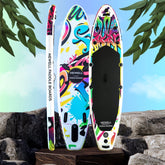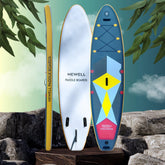How to Transport and Store Your Inflatable Paddle Board (SUP)
How to Transport and Store Your Inflatable Paddle Board (SUP)
Owning an inflatable paddle board opens up endless possibilities for water adventures, offering flexibility in where you paddle. Inflatable SUPs are not only lightweight and portable but can also be deflated and stored compactly when not in use. However, figuring out the best way to transport and store your board can make a big difference in your experience.
Here’s a guide to help you decide on the best methods for transporting and storing your inflatable paddle board, tailored to different needs and vehicle types.

Methods for Transporting Your Inflatable SUP
Folded Up in Its Travel Bag
Transporting your SUP folded up in its designated travel bag or backpack is one of the easiest and most common methods. The bag protects your board and makes it portable, allowing you to easily carry it from your car to the water.
Pros:
- Compact and easy to store in a car trunk or backseat.
- Perfect for smaller vehicles or when you need extra space for passengers or luggage.
Cons:
- Requires inflation and deflation at your destination, which can be time-consuming.
Tip: If you plan to inflate and deflate your board often, consider investing in an electric SUP pump to save time and effort.
Inflated and Strapped to the Roof of Your Vehicle
If you prefer to keep your SUP inflated between uses, strapping it to the roof of your vehicle is a great option. Use SUP tie-down straps to secure it to a roof rack, crossbars, or luggage rails.
Pros:
- No need to inflate/deflate the board every time you paddle.
- Frees up space inside your vehicle for other gear or passengers.
Cons:
- Requires extra care to securely strap the board and avoid damage while driving.
Tip: Always check the straps during long drives to ensure they remain tight. Straps that loosen can lead to board damage or accidents.
Inflated and Secured in a Pickup Truck Bed
For those with a pickup truck, transporting an inflated paddle board in the truck bed is another option. Simply place the board at a slant, securing it with tie-down straps. If the board extends past the bed, attach a flag or ribbon to the tail for visibility.
Pros:
- Convenient for quick loading/unloading without the need for inflation.
- No wind drag compared to rooftop transport.
Cons:
-
The board will likely extend beyond the truck bed, which requires careful securing and flagging to prevent damage or accidents.
Inflated and Placed Inside a Large Vehicle
Some larger vehicles, like vans or SUVs, can accommodate an inflated paddle board inside. You can place the nose between the front seats and allow the board to extend into the back.
Pros:
- Protects the board from external weather conditions.
- Avoids any issues with rooftop straps or wind drag that can affect fuel efficiency.
Cons:
- Limited to larger vehicles with enough interior space.
- Heat inside the vehicle can increase board pressure, potentially leading to damage.
Tip: If transporting inside your vehicle, reduce the pressure of the board slightly and avoid leaving it in direct sunlight to prevent overexpansion.
Stacked on a Trailer with Multiple Boards
For those transporting multiple boards, such as a rental fleet or a family trip, trailers can offer an efficient solution. Kayak trailers are commonly used, and you can stack several paddle boards nose-to-tail on each arm of the trailer.
Pros:
- Ideal for transporting multiple boards at once.
- Trailers offer easy loading and unloading.
Cons:
- Requires a trailer hitch and sufficient towing capacity.
- You may need additional straps to prevent boards from shifting during transit.
Best Practices for SUP Transport
- Avoid Hard Surfaces: Make sure your board doesn’t scrape or bump into hard surfaces while being transported.
- Don’t Overtighten Straps: Overtightening can damage the board’s material.
- Protect Edges: Use padding to protect the board’s edges from damage during transportation.
Storing Your Inflatable Paddle Board
Proper storage is crucial for extending the life of your SUP. Here are a few tips on how to store your board:
- Store in a Cool, Dry Place: Avoid exposure to extreme temperatures or direct sunlight for long periods. Prolonged exposure to UV rays can weaken the material.
- Roll It Up for Compact Storage: When deflated, roll up your board starting from the tail. Use the bag or backpack it came with for easy storage.
- Avoid Creases: Try to avoid sharp folds when storing your deflated SUP to prevent permanent creasing.
- Check for Moisture: Ensure the board is completely dry before storing it to prevent mold or mildew from forming.
Transporting and storing your inflatable paddle board doesn’t need to be complicated. Whether you opt to transport it deflated in a travel bag, inflated on your roof, or secured in a truck bed, each method has its own advantages. The key is finding a solution that works for your vehicle, storage space, and lifestyle.
By following these guidelines, you can safely transport your SUP to any waterway, protect your investment, and focus on enjoying your time paddling. Proper care and transport will ensure your paddle board stays in great condition for years of adventures.
At Newell Outdoors, we’re committed to providing you with the best paddleboarding gear and advice to help you make the most of your time on the water. Whether you’re a beginner or a seasoned pro, following these tips will help you paddle with confidence and enjoy every moment on your board.
Ready to start your paddleboarding adventure? Explore our range of high-quality boards and gear at Newell Outdoors, and get out on the water today!
- Everything You Need to Know About Paddleboard Fin Placement
- Choosing Between Solid (Hard) Paddle Boards and Inflatable Paddle Boards: Understanding the Differences
- How to Paddleboard with your Kids
- How to Stand Up Paddle Board With Your Dog
- What is SUP Yoga: Basics and Benefits
- How to Install a Paddleboard Center Fin in 6 Steps
- How to Inflate and Deflate Your Inflatable Paddle Board
- What is a Paddleboard Safety Leash and How to Attach It












